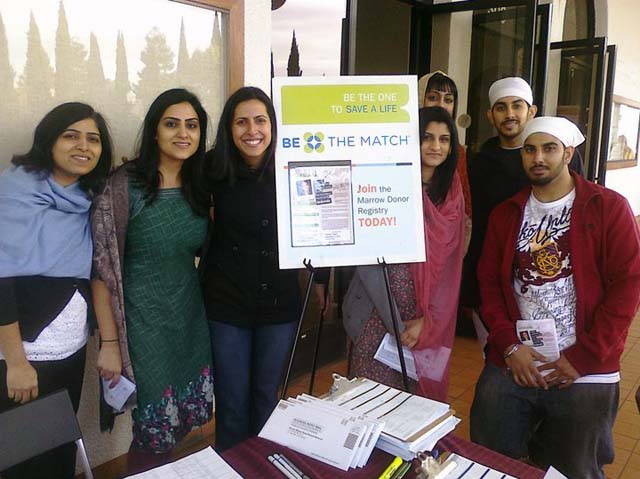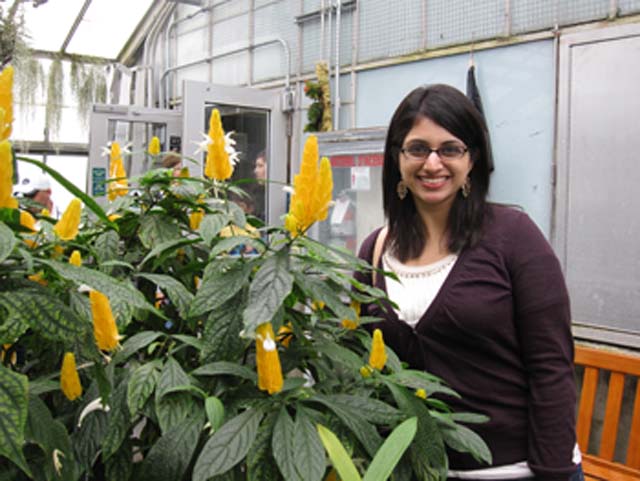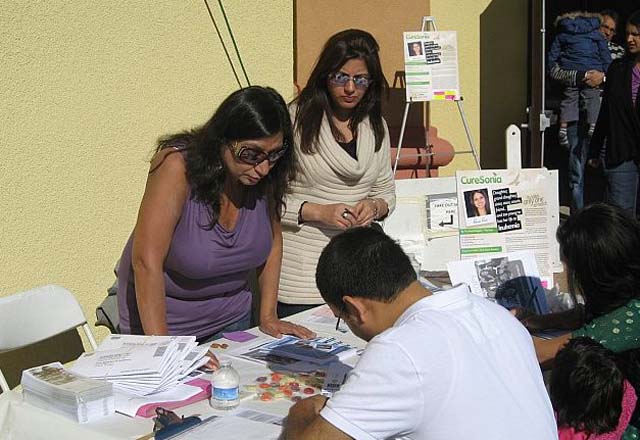
South Asian Health – A Wakeup Call
Sonia Rai, South Asians & the Bone Marrow Drive
Related Article:
Did you know that if you are a South Asian and get Leukemia, your chances of survival can depend on a bone marrow match from another South Asian? While 30 % of patients will find a matching donor within their family, the remaining 70 % have to search for a match from unrelated donors.
The odds are 1 in 20,000 to 1 in a 100,000 in identifying an unrelated compatible marrow donor… much higher, however, for patients of minority heritage. The hard fact is that only 1% of South Asians are registered with the National Marrow donor program.
Life can change in the blink of an eye. It happened to Sonia Rai, 24, a risk analyst in Boston, when a routine visit to a dentist turned into a nightmare scenario. She was diagnosed with Acute Myeloid Leukemia and is desperately seeking a match.
Yet for readers, these names which appear in occasional Leukemia donor drive alerts are often just names, and they don’t connect with the real life people behind these human traumas.
Do they really know Sonia Rai – daughter, grand-daughter, sister, niece, cousin, friend – and too young to lose her life to Leukemia?

Meet Sonia Rai: Daughter, Sister, Friend…
An Update from Sonia’s brother: Folks, based on Sonia’s genetics, her “match” will likely be a blend of Southeast Asian & Caucasian. This is commonly found in Hawaii, Philippines, Pakistan, Papua New Guinea (PNG), Burma, Nepal, and North India. For the regions outside North India, if you know ANYONE, please direct them to one of the CureSonia drives this weekend as we are trying to expand the search to other applicable target areas. Thanks, Sumit
Here are a few glimpses of Sonia Rai, as described by her friend Tuhina Dayal.
“Sonia and I met about three years ago when we were both new to the Boston area and didn’t really know anyone. We’ve been practically joined at the hip since then – exchanging numerous emails a day – meeting at least once a week but more often generally – best friends. She’s such a vivacious personality – her laughter is infectious and she has such a positive attitude. She’s sweet and thoughtful and easy to talk to – never judgmental.”
Tuhina recalls the fateful night they discovered that life was about to change dramatically. “Friday, December 10, my friend Manisha and I were leaving a party around 10pm. Out of habit I pulled my phone out of my purse and saw that I had a text message from Sonia and a voicemail from an unknown number. Sonia’s text message read: “I got a lot worse… parents are taking the red eye. I’m going to MGH ER… can you come?” (MGH = Massachusetts General Hospital)
Sonia had gone to a dentist appointment earlier that day and had an adverse reaction to the procedure causing her face to swell. Manisha decided to come to the ER as well because we thought the doctors would give Sonia a shot for her allergic reaction, and send her on her way. Little did we know Sonia wouldn’t be leaving the hospital again – it’s a month later, and she’s still there.”
The blood tests in the ER revealed that she had Acute Myeloid Leukemia . A bone marrow biopsy showed that almost 100% of her cells were cancerous. Sonia was started on 7 days of induction chemotherapy.
“After the initial weekend, when the shock wore off, she was back to her normal self – joking with me, reminiscing about our crazy adventures in Boston, chitchatting about Bollywood movies and Bollywood trivia… well, she was almost her normal self – she was definitely tired and the chemo was wreaking havoc on her body – but she was strong and had a positive outlook,” says Tuhina.
“She never complained or even felt sorry for herself. It took almost a week to ten days for the swelling in her face to go down – but Sonia looked like herself – just a tired version of herself. To give you an example of how selfless Sonia is – she kept apologizing to me about disrupting my life – or if she fell asleep while I was visiting, she would apologize later.”
Then began the waiting game….
CureSonia
The hospital monitored Sonia’s blood counts and her vitals for a full week. Then another bone marrow biopsy was done – and it revealed that 15% of her cells still remained cancerous. It was decided that since Sonia was young and otherwise healthy, a second round of chemotherapy should be started to see if they can bring the percent of cancerous cells below 5%.
Tuhina once again describes the following days: “During the first round of chemo and waiting period – I was able to visit Sonia nearly every day. But the second round of chemo has been far harder on her body – because of that, I haven’t been able to visit Sonia as often. I did go a few days back, on the last day of her second round of chemo and she definitely looked different – her skin had a grey cast to it and even though she was talking normally – I could tell it was taking a lot out of her. During this time is when her hair started falling out.
She told me that she would cry every day when her mom brushed clumps of hair out – but even then she managed to stay positive, saying to me: ‘Given the choice of being bald or dead, I’m going to choose bald.’

As the days go on, Sonia Rai fights to keep her sense of humor and the hope that she will triumph over the disease. The best chance of Sonia’s survival is if she finds a bone marrow donor. Unfortunately, Sumit, Sonia’s brother turned out to not be a match, but he has started a massive campaign CureSonia.org to get the word out. Somewhere out there, amongst the hundreds of thousands of South Asians, there could be a match.
“Finding a donor as a South Asian is challenging because matches are genetically and thus, often ethnically matched,” says Sumit. “Only 1 % of the National Registry is South Asian. In addition, India does not have any very developed registries yet – a few tiny ones exist, but registrants are very low.”
South Asian Community Initiatives
The need for the South Asian community is to unite on this issue and take on a massive campaign to ensure that more people register for the bone marrow drives and thus increase the pool of South Asian matches on the National Registry. Registration and donation is quite easy as most donations today – above 80% and the kind Sonia will have – are done through PBSC which is much easier than traditional bone marrow.
South Asian Americans have been hands-on and pro-active on many issues pertaining to the health and well-being of others. Joining the National Registry is one step that everyone can take – it can save Sonia and many others like her.
The tide certainly seems to be turning as more and more South Asians are stepping up to the plate, and helping to create awareness and also hold bone marrow registration drives in different parts of the country for Sonia and others who need this bone marrow match.
Please visit CureSonia.org, to find out the various venues and get yourself registered. You can also help host a drive in your city and invite South Asians to help scale the CureSonia effort across more cities in the US.
Sonia Rai writes on her Facebook page: “I want to thank each and everyone who has been so supportive during this difficult time for me. The love and support that everyone has given me has truly made me speechless, and given me the strength to fight this.”
Cure Sonia: Sacha Dhawan, Surina Jindal and Sunkrish Bala
Facts about Bone Marrow Donor Registration
Joining the registry is easy. Patients need donors who are between the ages of 18 and 60, meet the health guidelines and are willing to donate to any patient in need. When you come to a donor drive, we will explain what it means to become a donor, help you understand your commitment, answer your questions and help you through the process. All you need to do is: – Complete a registration form with contact information, healthy history questions and a signed agreement to join the registry. To help you complete the form, bring along: – Personal identification (such as a driver’s license or passport) – Contact information for two family members or friends who would know how to reach you in the future if your address changes. – Give either a swab of cheek cells or a blood sample so your tissue type can be tested. That’s it! Your tissue type is then added to the National Registry. Doctors search our Registry when they need to find a donor for their patients.
Some facts: Registering as a marrow/stem cell donor requires only a simple, buccal swab test (a sample collection of your saliva), and completion of a donor form. The National Marrow Donor Program (NMDP) does the tissue typing, and puts the donor in a national registry. If there ever is a match between a patient and a potential donor, the donor will be contacted by the center or Donor Recruitment Group that they were tested by. The donor will be asked to provide a sample of blood at that time, that will undergo a few higher-level of testing, to determine exact compatibility of donor to patient.
South Asian donors needed
Every year many South Asian patients are diagnosed with blood-related diseases. In order to survive, Sonia and many other patients need a bone marrow transplant from a matching donor. Nearly 30% of patients will find a matching donor within their families. The remaining 70% must search for an unrelated donor. Unfortunately, a very small percentage of South Asians (Indians, Pakistanis, Sri Lankans and Bangladeshis) are registered to be marrow donors. South Asians comprise approximately only 1% of the National Marrow Donor Registry.
What is the National Marrow Donor Program (NMDP)?
National Marrow Donor Program is a federally supported organization that assists in locating unrelated donors.
What exactly is a marrow / stem cell transplant? Simply, it is the replacement of diseased blood stem cells from a health donor infused into a patient’s vein just like a blood transfusion. Within four to six weeks the transplanted marrow / stem cells begin to produce normal blood cells in the patient.
Is marrow/stem cell transplantation a proven technique?
Twenty years ago marrow transplants were done only as a patient’s last hope. Today, thousands of lives are saved every year at approved medical centers worldwide.
Which diseases can be treated by marrow transplant?
Over 70 diseases including the leukemia’s, aplastic anemia, severe combined immune deficiency, sickle cell anemia and radiation poisoning are treated by marrow transplant.
What are the actual chances of finding a suitable marrow or stem cell donor?
The odds are 1 in 20,000 to 1 in a 100,000 in identifying an unrelated compatible marrow donor… much higher, however, for patients of minority heritage. YOU could be that special life-giving person!
Are donors matched only against American patients?
No, the patient could be anywhere in the world. Many American patients have found donors from International donor sources.
Who can become a marrow / stem cell donor?
You must be between 18 and 60 years old, have no history of hepatitis, heart disease, cancer or AIDS, and sign a consent form allowing the Registry to include your HLA tissue type in its confidential files for future matching. See NMDP link below for more details: Donor information (NMDP) and Donor Eligibility Guidelines.
When is the blood drawn?
The blood is drawn at a laboratory in your community, or by your personal physician or at a hospital, when your are identified a s a possible match.
How do I know if I am a match?
If you are found to be a possible match with a patient, the center in which you tested and/or the NMDP will contact you immediately and give you the option of proceeding to the next level/s of testing to insure final HLA compatibility with the patient. Who pays for these tests? Not you – the patient or his/her medical insurance does.
What happens if I am a match?
If the match is confirmed the transplant can be scheduled but only with your legal consent after in-depth counseling and a thorough physical examination.
Okay, now tell me how my marrow is collected?
Peripheral blood stem cell collection (MOST current and common method)…..You are given small injections of Neupogen/Filgrastin for 3 to 5 days to force your marrow to overproduce marrow or stem cells which are then released into your circulating blood. The stem cells are collected by removing blood from a vein in your arm, passing it through a filter system, which collects the stem cells and returns the remaining blood to you…a 2 to 3 hour procedure.
Are there any risks or side effects?
1. Peripheral blood stem cell collection (PBSC)…..You might experience some flu- like symptoms, slight bone pain, or a feeling of heaviness during the injections. These discomforts usually disappear soon after the collection is completed. This will be discussed in detail with you. 2. Marrow harvest…..Other than the remote chance of a reaction to anesthesia or an infection the risks are minimal. This will be explained to you in detail. You may experience some soreness in the lower back.
There is more info here
Please visit and like this FB page to get the word out.
Related Article:

7 Comments
Lavina Naidoo, my prayers are with you – I do hope you get a match. I have linked to your Dancing Peanut Campaign on my personal page as well as the Lassi with Lavina page to create awareness.
https://www.facebook.com/LassiwithLavina
Please check out http://www.facebook.com/dancingpeanutcampaign. It was created for my 2-yr-old Vearin who needs a bone marrow donor as he was diagnosed with acute myeloid leukemia in April this year. We live in South Africa and he is South Indian. Keep up the good work and hopefully we get a match for my baby boy
Hi Suparna, thanks for your comment. Isn’t it much harder for South Asians to find a match? Are there many registries in India and are the linkages between these registries global?
Hi Firdosh, thanks for the information. I think you should post this information on the CureSonia page on Facebook as it is accessed by many people who are looking for a match or want to help.
Sonia left for her heavenly abode on Sunday, 10th March 2012. She chose to be at rest in peace with Almighty God. Let’s all pray for her beautiful and bubbly soul.
Rest in peace, Sonia…you will always be with us.
Please contact Firdosh about his registry.
My research focuses on bone marrow transplantation at Stanford University School of Medicine. Therefore I know the challenges of finding a match.
I have started a small registry here in Pune, India.
Please let me know if I can be of help